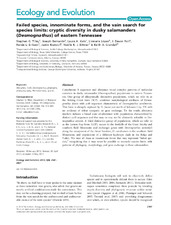| dc.description.abstract | Cytochrome B sequences and allozymes reveal complex patterns of molecular
variation in dusky salamander (Desmognathus) populations in eastern Tennessee.
One group of allozymically distinctive populations, which we refer to as
the Sinking Creek form (SCF), combines morphological attributes of Desmognathus
fuscus with cytB sequences characteristic of Desmognathus carolinensis.
This form is abruptly replaced by D. fuscus just north of Johnson City, TN with
no evidence of either sympatry or gene exchange. To the south, allozymic
markers indicate a broad zone of admixture with populations characterized by
distinct cytB sequences and that may or may not be ultimately referable to Desmognathus
conanti. A third distinctive group of populations, which we refer to
as the Lemon Gap form (LGF), occurs in the foothills of the Great Smoky and
southern Bald Mountains and exchanges genes with Desmognathus santeetlah
along the escarpment of the Great Smokies, D. carolinensis in the southern Bald
Mountains, and populations of a different haplotype clade in the Ridge and
Valley. We treat all these as innominate forms that may represent “failed species,”
recognizing that it may never be possible to reconcile species limits with
patterns of phylogeny, morphology, and gene exchange in these salamanders. | en |



